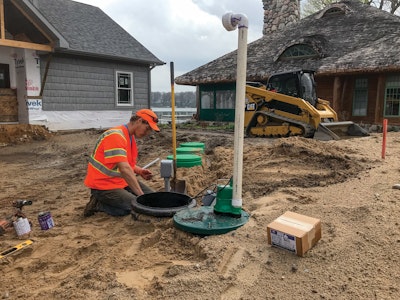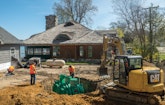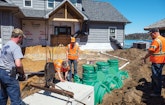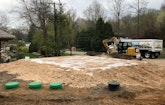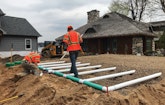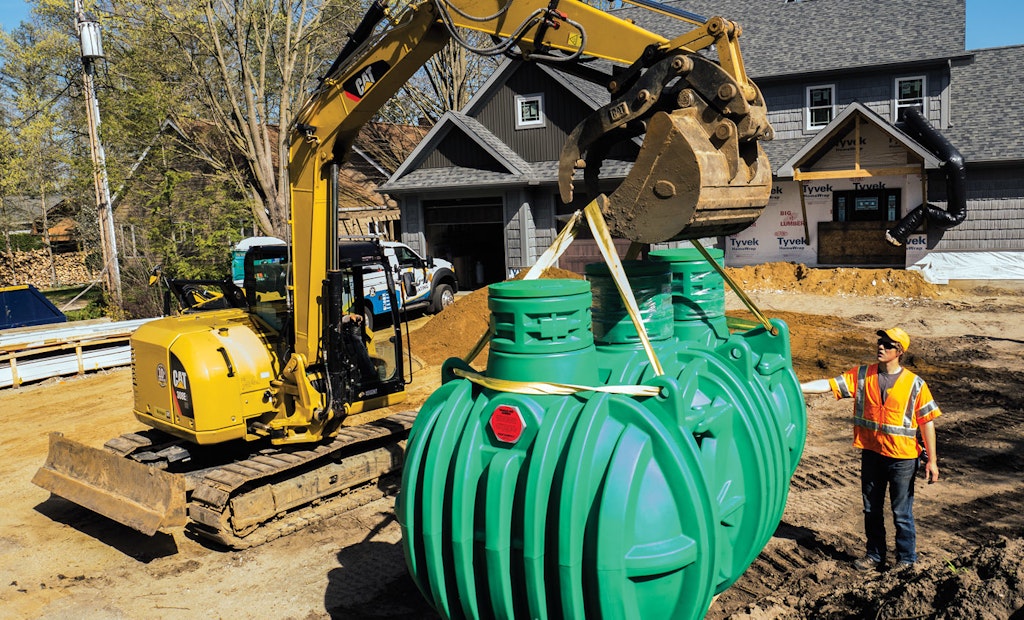
Josh Sanders (right) and Dervin Witmer (in Cat excavator) swing the Norweco Singulair Green ATU into position at the job site in Three Rivers, Michigan. (Photos by Lucian Allen Photography)
Dervin Witmer got a call from a friend who built a house. He needed help. Witmer owns Dig-It Excavating in Cassopolis, Michigan, in the southwestern corner of the state, and his friend needed different wastewater options for the house.
The project involved tearing down an old cottage and building a new, larger, four-season home on a lot right beside a lake. The owners had two goals for their wastewater system.
“One was environmental: They wanted to keep the lake clean and not contribute to the algae problem. But they also wanted alternative technology because of the space they had available,” Witmer says.
When the home was first proposed to the county, the design called for a standard wastewater system. There was a 1,500-gallon septic tank, a 500-gallon dosing tank, and an 800-square-foot drainfield in a sand mound built up to give adequate separation from the 12-inch seasonal water table.
Then came the twist that brought the job to Witmer. After the house was up, the contractor discovered a neighbor’s well had not been included in the permit information. Setback requirements left no room for the conventional system in the original design. That’s when Witmer’s friend called.
Witmer suggested the Norweco Singulair Green. It is a single tank, and with other changes to the home, the drainfield could be reduced to 600 square feet.
Softener solution
Witmer helped reduce the size of the drainfield by eliminating the garbage disposal called for in the plan and by rerouting the discharge from the home’s water softener. He ran the softener discharge pipe into a trench beside the drainfield. Because that discharge is only mineral-heavy water with no load of organics or pathogens, the county was fine with this change.
Wastewater leaves the house in a 4-inch Schedule 40 polyvinyl chloride pipe and runs about 25 feet to the Singulair tank. There were heavy rains in the spring of 2017, but those were followed by a couple months of dry weather. By the time Witmer’s crew did the installation, the water table was low enough so technicians could set the plastic Singulair tank by itself with some anti-flotation anchors. And Singulair tanks are never pumped dry, so there is always some water for ballast, Witmer says.
About 2 feet from the Singulair was a separate 500-gallon concrete dosing tank, from Dave’s Concrete Products in Lawton, containing a Myers MSCI50T10 pump. A 2-inch Schedule 40 pressure line comes out of the dosing tank and runs about 20 feet before it enters the header of the drainfield.
To construct the 20-by-30-foot drainfield, Witmer’s crew stripped the top 8 to 10 inches of topsoil and backfilled with 4 feet of sand. The header was 4-inch solid STR 35 pipe. Inside the sand bed are seven laterals made with 4-inch perforated foam core pipe on 3-foot centers. All the pipe was bedded in 3/8-inch washed native stone.
The Singulair has the optional tertiary treatment UV system, and Norweco’s basic panel runs the system. Norweco’s lids cover the tank. On the dosing tank, Witmer used Romotech lids.
To do the job, Witmer used a Cat 299D track loader, and a Cat 308E2 excavator to set the tank and build the field. The company’s 2015 Kenworth T880 quad-axle dump truck hauled the sand and gravel in its J&J Truck Bodies & Trailers dump box.
Because the space was so constrained, site restoration was straightforward. Sod went on top of the system, and that accounted for most of the front yard. Witmer’s crew planted native grasses around the edge. The owners had space for a few flowers.
Spreading the technology
Fitting a system to the space was the big challenge. Installation went smoothly, and Witmer is pleased about having a chance to expand this use of treatment technology.
Michigan doesn’t have a standard, statewide septic code, Witmer says. Interpretation of what state standards there are is left to individual county health departments. And it would be difficult to write a comprehensive state code because the soils vary so much, he says. The eastern side of the state, near Lake Huron, has heavy soils with little sand. The western side, where Witmer lives near the shore of Lake Michigan, has a great deal of sand and water and minimal amounts of heavy soils.
“We feel like we were helping to pioneer this alternative technology and help local health departments see what is possible. Because of this installation, St. Joseph County rewrote their rules to require a maintenance contract when a property owner chooses an ATU,” he says.
And the local health department staff took factory training from Norweco so they could understand the product better.
“I think within 6 miles of the local town there are like 36 inland lakes. So alternative technology is something we should be on top of in this area with so many lakes and the building happening around them,” Witmer says.
